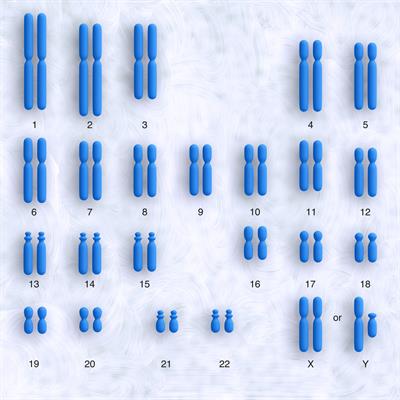PDF chapter test TRY NOW
In \(1923\), Theophilus Painter, an American zoologist, discovered the number of human chromosomes. He detected \(24\) pairs of chromosomes using the microscope, which equates to 48. It was not until \(1956\) that Indonesian-borncytogeneticist Joe Hin Tjio discovered the correct number as \(46\). These \(46\) chromosomes have different functions.
Example:
Chromosome \(2\) consists of \(1,200\) to \(1,300\) genes that provide instructions for creating proteins. These proteins have a wide range of functions in the body.
Each chromosome differs from one another based on the length, thickness, centromere position, shape.
The number, size, and shape of chromosomes in an organism's cell nucleus is called a karyotype.

Human karyotype
Lev Delaunay is the first to describe the karyotype as the phenotypic appearance of somatic chromosomes in \(1922\) without considering their genetic contents. Nettie Stevens discovered sex chromosomes in mealworms in \(1905\), when she saw that male cells had one chromosome that was smaller than the others, whereas female cells had all chromosomes that were the same size.
Any living entity (animal or plant) has the same number of chromosomes. Each cell in the human body has \(23\) pairs of chromosomes. The autosomes makeup \(22\) pairs, while the allosome, or sex chromosome, makes up the \(23\)'rd pair.
The chromosomes are usually found in pairs in the body cells of sexually reproducing organisms, referred to as a diploid condition (2n). The organisms produce gametes with a single pair of chromosomes. Thus, the gametes are described as haploid (n).
Important!
An ideogram is a diagrammatic representation of a species' karyotype. It comprises all metaphasic chromosomes arranged in homologous pairs to decrease length, thickness, centromere position, shape, and so on, with the sex chromosomes at the end.
